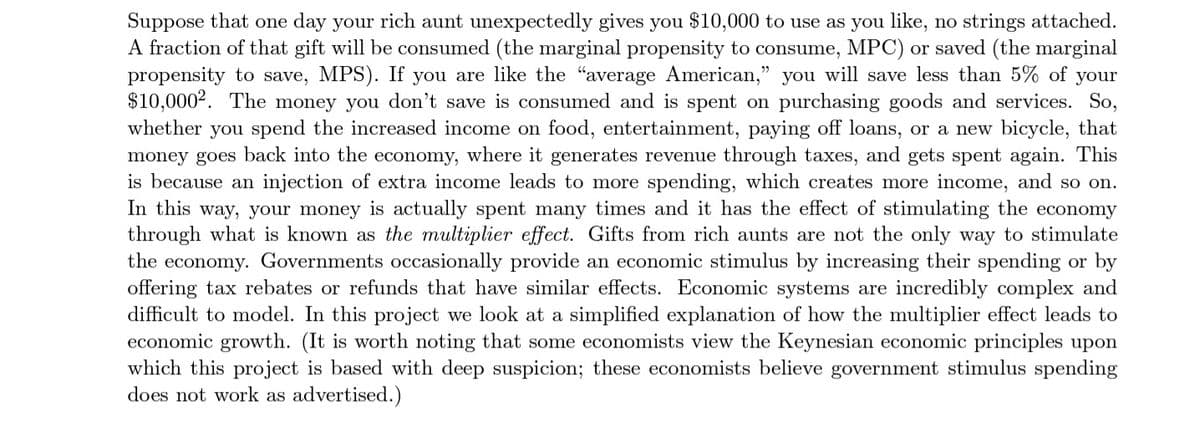14. Explain the statement that for small spending rates (r < 1/2), the percentage change in the spending rate is greater than the percentage change in the economic impact, while for large spending rates (r > 1/2), the percentage change in the spending rate is less than the percentage change in the economic impact.
14. Explain the statement that for small spending rates (r < 1/2), the percentage change in the spending rate is greater than the percentage change in the economic impact, while for large spending rates (r > 1/2), the percentage change in the spending rate is less than the percentage change in the economic impact.
Economics (MindTap Course List)
13th Edition
ISBN:9781337617383
Author:Roger A. Arnold
Publisher:Roger A. Arnold
Chapter10: Keynesian Macroeconomics And Economic Instability: A Critique Of The Self Regulating Economy
Section: Chapter Questions
Problem 8QP
Related questions
Question
The formula for economic impact is I(r)=(A)/1-r
The formula for impact change is ∆I= I'(r)*∆r
The formula for percentage change is g(r)=(r)/1-r

Transcribed Image Text:14. Explain the statement that for small spending rates (r < 1/2), the percentage change in the spending
rate is greater than the percentage change in the economic impact, while for large spending rates
(r > 1/2), the percentage change in the spending rate is less than the percentage change in the
economic impact.

Transcribed Image Text:Suppose that one day your rich aunt unexpectedly gives you $10,000 to use as you like, no strings attached.
A fraction of that gift will be consumed (the marginal propensity to consume, MPC) or saved (the marginal
propensity to save, MPS). If you are like the "average American," you will save less than 5% of your
$10,0002. The money you don't save is consumed and is spent on purchasing goods and services. So,
whether you spend the increased income on food, entertainment, paying off loans, or a new bicycle, that
money goes back into the economy, where it generates revenue through taxes, and gets spent again. This
is because an injection of extra income leads to more spending, which creates more income, and so on.
In this way, your money is actually spent many times and it has the effect of stimulating the economy
through what is known as the multiplier effect. Gifts from rich aunts are not the only way to stimulate
the economy. Governments occasionally provide an economic stimulus by increasing their spending or by
offering tax rebates or refunds that have similar effects. Economic systems are incredibly complex and
difficult to model. In this project we look at a simplified explanation of how the multiplier effect leads to
economic growth. (It is worth noting that some economists view the Keynesian economic principles upon
which this project is based with deep suspicion; these economists believe government stimulus spending
does not work as advertised.)
Expert Solution
Step 1
* Hi there , as you have posted multiple questions , as per our guidelines we are only going to solve the first one . Kindly repost the remaining to get it solved*
Given ,
The formula for economic impact is I(r)=(A)/1-r ---(i)
The formula for impact change is ∆I= I'(r)*∆r ---(ii)
The formula for percentage change in spending is g(r)=(r)/1-r ---(iii)
Step by step
Solved in 2 steps

Knowledge Booster
Learn more about
Need a deep-dive on the concept behind this application? Look no further. Learn more about this topic, economics and related others by exploring similar questions and additional content below.Recommended textbooks for you

Economics (MindTap Course List)
Economics
ISBN:
9781337617383
Author:
Roger A. Arnold
Publisher:
Cengage Learning


Economics (MindTap Course List)
Economics
ISBN:
9781337617383
Author:
Roger A. Arnold
Publisher:
Cengage Learning
